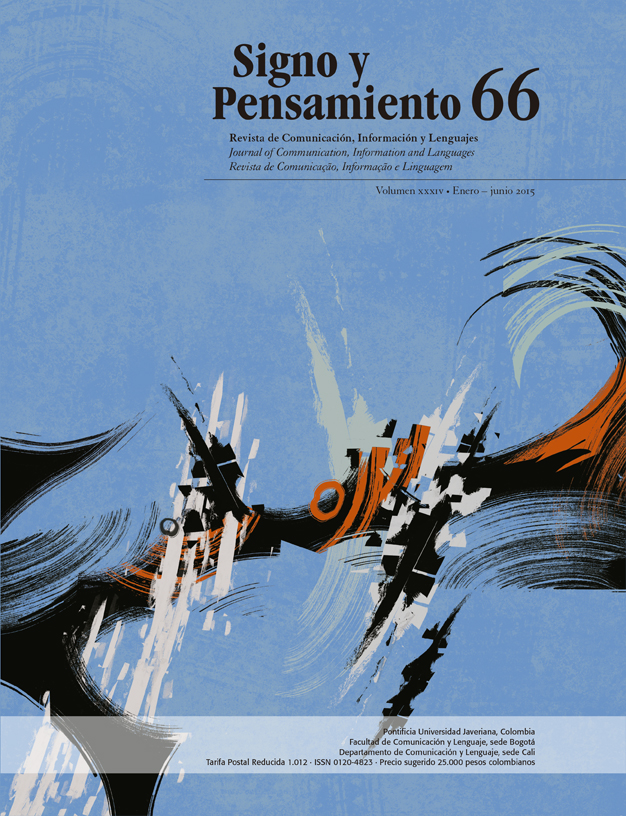Abstract
The Colombian regional public television inherited from national public television its main shortcomings. Some of these shortcomings are the politicization and commercial orientation.
The present article claims that such a situation is associated with the model under which these channels are oriented, where content is designed more for profitability to ensure its sustainability than for public service. From the concept of audience-commodity suggested by the Political Economy of Communication the article reflects how the regional public television should disassociate from the logics imposed by commercial TV, and thus generate an independent bid, plural and diverse, that should not be measured and evaluated with market parameters or fall into disrepair or in the inertia of national public channels.
Arroyo, L.; Becerra, M.; García, Á. y Santamaría, O. (2012). Cajas mágicas. El renacimiento de la televisión pública en América Latina. Madrid: Editorial Tecnos.
Artz, L. (2008). Media relations and media product: Audience commodity. Democratic Communiqué, 22(1), 60-74. Disponible en: http://journals.fcla.edu/demcom/article/view/76591
ASOMEDIOS, Asociación Nacional de Medios de Comunicación (2014). Estudio de inversión publicitaria neta: revistas-radio-televisión. 4° trimestre 2013. Bogotá: ASOMEDIOS.
Atkinson, D. y Raboy M. (Comps.). (1998). La radio y la televisión de servicio público: el desafío del siglo XXI. Francia: Ediciones Unesco.
ANTV, Autoridad Nacional de Televisión (2013). Respuesta observaciones al proyecto de Reglamentación del FONTV. Bogotá: ANTV. Disponible en: http://www.antv.gov.co/sites/default/files/130131_respuesta_observaciones_reglamentacion_ fontv_0.pdf
Bolaño, C. (2006). Tapando el agujero negro. Para una crítica de la economía política de la comunicación. Cuadernos de Información y Comunicación, 11, 47-53.
Fuchs, C. (2012). Dallas Smythe Today - The Audience Commodity, the Digital Labour Debate, Marxist Political Economy and Critical Theory. TripleC, 10(2), 692-740.
García-Canclini, N. (1995). Consumidores y ciudadanos. Conflictos multiculturales de la globalización. México: Editorial Grijalbo.
García, D. y Herrera, L. (2011). El Caribe colombiano a través de su televisión: Agenda informativa y realidad regional en Telecaribe. Bogotá: Fondo de Publicaciones Universidad Sergio Arboleda.
García, D. (2012). Breve historia de la televisión regional en Colombia. Revista Latinoamericana de Ciencia de la Comunicación, IX(16), enero-junio, 64-72. Disponibe en: http://www.alaic.net/revistaalaic/index.php/alaic/article/view/373/206
Igarzábal, B. (2013). Por una televisión pública con audiencia. En O. Rincón, Zapping TV: el paisaje de la tele latina (pp. 51-70). Bogotá: FES.
Intervozes. Coletivo Brasil de comunicação social. (2009). Sistemas públicos de comunicação no mundo. Experiências de doze países e o caso brasileiro. São Pablo: Paulus.
Jakubowicz, K. (2010). El futuro de los medios públicos. Infoamérica, (3-4), 221-238.
Jhally, S. (1982). Probing the blindspot: the audiende commodity. Canadian Journal of political and social theory, 6(1-2), 204-210.
Livant, B. (1979). The audience comodity: on the “blindspot” debate. Canadian Journal of political and social theory, 3(1), 91-106.
Marín, A. M. (2006). Televisión pública en Colombia: del monopolio estatal a la descentralización. En Radiotelevisión de Servicio Público: Un Manual de Mejores Prácticas (pp. 95-118). Costa Rica: UNESCO.
Martín-Barbero, J.; Rey, G. y Rincón, O. (2000). Televisión pública, cultural, de calidad. Revista Gaceta, (47), 50-61.
Murdock, G. (1978/2006). Los agujeros negros del marxismo occidental: Respuesta a Dallas Smythe. Cuadernos de Información y Comunicación, 11, 11-22.
Narváez, A. (2013). Mercado de medios y esfera pública en Colombia. Revista Eptic Online, 15(1), 49-66. Disponible en: http://www.seer.ufs.br/index.php/eptic/article/view/704
Ortega. P. (2010). Televisión pública en América Latina: los valores del mercado y las políticas del Estado. Infoamérica, (3-4), 205-213.
Rey, G. (2002). La televisión en Colombia. En G. Orozco (coord.). Historias de la televisión en América Latina. Barcelona: Gedisa.
Sánchez, F. (2013). Retos de la televisión pública en Colombia: la implementación de la TDT en los canales regionales. V Congreso Internacional Latina de Comunicación, Universidad de La Laguna. Disponile en: http://www.revistalatinacs.org/13SLCS/2013_actas/117_Sanchez.pdf
Scolari, C. (2008). This is the end. Las interminables discusiones sobre el fin de la televisión. Trama de la comunicación, 13, 13-25.
Scholz, T. (Ed.). (2013). Digital Labor. The internet as playground and factory. New York: Routledge.
Smythe, D. (1977). Communications: Blindspot of western Marxism. Canadian Journal of political and social theory, 1(3), 1-27.
Smythe, D. (2006). Réplica a Graham Murdock. Cuadernos de información y Comunicación, 11, 23-30.
UNESCO. (2001). La Radio y Televisión Pública. ¿Por qué? ¿Cómo? Paris-Canadá: UNESCO.
Vizcaíno, M. (1992). Los falsos dilemas de nuestra televisión. CEREC: Bogotá.
Vizcaíno, M. (2005). La legislación de televisión en Colombia: entre el Estado y el mercado. Historia Crítica, 28, 127-144.
Wolton, D. (1990). Elogio del gran público. Una teoría crítica de la televisión. Barcelona: Gedisa.
This journal is registered under a Creative Commons Attribution 4.0 International Public License. Thus, this work may be reproduced, distributed, and publicly shared in digital format, as long as the names of the authors and Pontificia Universidad Javeriana are acknowledged. Others are allowed to quote, adapt, transform, auto-archive, republish, and create based on this material, for any purpose (even commercial ones), provided the authorship is duly acknowledged, a link to the original work is provided, and it is specified if changes have been made. Pontificia Universidad Javeriana does not hold the rights of published works and the authors are solely responsible for the contents of their works; they keep the moral, intellectual, privacy, and publicity rights.
Approving the intervention of the work (review, copy-editing, translation, layout) and the following outreach, are granted through an use license and not through an assignment of rights. This means the journal and Pontificia Universidad Javeriana cannot be held responsible for any ethical malpractice by the authors. As a consequence of the protection granted by the use license, the journal is not required to publish recantations or modify information already published, unless the errata stems from the editorial management process. Publishing contents in this journal does not generate royalties for contributors.


